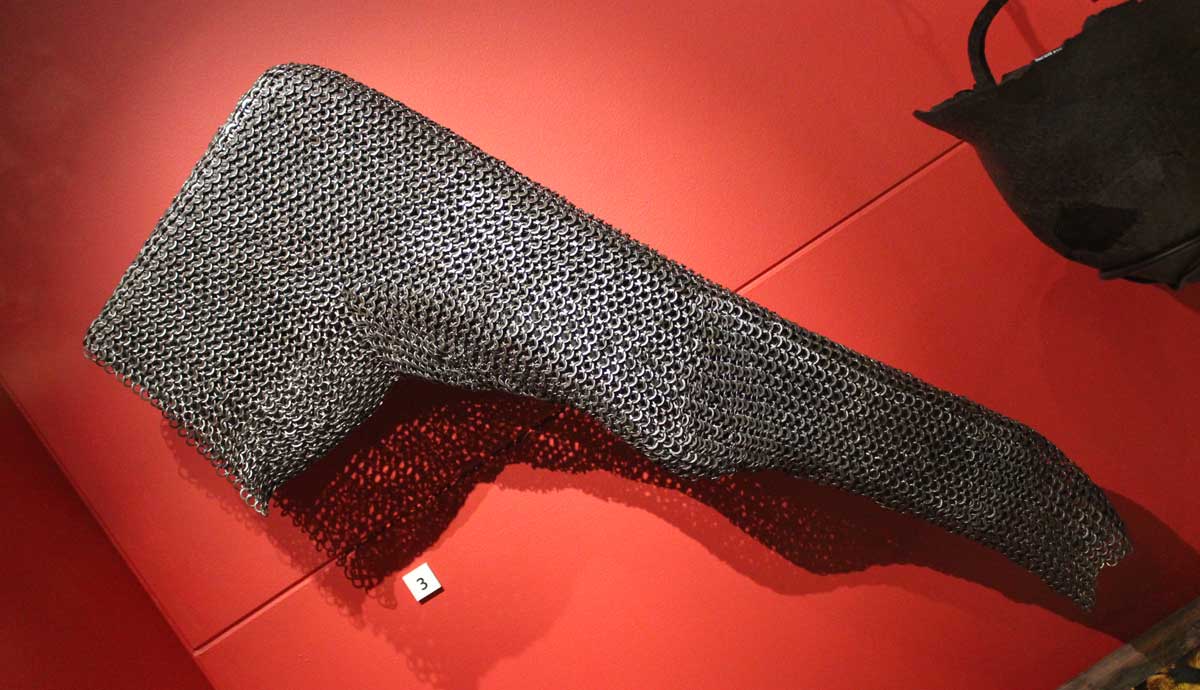 Mail sleeves in the Royal Armouries Collection at the Tower of London. © Lonnie Colson 2017.
Mail sleeves in the Royal Armouries Collection at the Tower of London. © Lonnie Colson 2017.
Maille Sleeves in Wide Usage
This pair of tailored mail sleeves were commissioned in 2018 and created by Nick Checksfield. Nick has been making and restoring mail since 1992. He is currently an educator at Windsor Castle but has worked in the past as a mail restorer at the Wallace Collection. Nick has also been seen as a mail subject expert in documentaries such as "Going Medieval" with Mike Loades. Nick has handled the originals in the Royal Armouries Collection at the Tower of London. They originals are constructed of 7mm riveted rings and have broad gussets and armpits. The arms taper down to a narrow wrist and feature a slight angle at the elbow to allow for better movement. The edges of the gussets and cuffs are still bound with a dark brown leather. The reproduction sleeves are constructed of 6mm mild steel round riveted rings with alternating rows of solid punched rings.
An invaluable resource for researching the everyday household expenses of the knightly class, Manners and household expenses of England in the thirteenth and fifteenth centuries. The third section deals with accounts and memoranda of Sir John Howard, first Duke of Norfolk, from 1462 to 1471. Recorded on folio 48b, Howard bought a brigandine and separate sleeves for 12 shillings on 5 September 1463:
Item, payd to Clayson of Herwysche ffor a peyre of breganderys and the sklevys, the v. day of Septembyr, xij.s.
When he issued brigandines to one of his servants or retainers, he often gave the man sleeves of mail, a standard of mail, or both, at the same time. On 2 September in the 8th year [1468] of the reign of King Edward IV, Howard gave 50 shillings to one of his men and directed him "to go in to his country to get bows for master Nicholas [Howard]" who was preparing to go to sea with the army under Lord Scales. Beginning on folio 110, at least 44 pairs of brigandines are handed out individually to his retainers. One example describes the crimson velvet-covered brigandine along with a pair of maille sleeves, sallet with visor, and a Welsh bill:
John Hobes, a pare of breganders set on cremysyn velvet, and a pare of sleves of maylle, a salet wyth a veser and a Walshe bille, xxxix.s. iij.d.
A Brief History of Maille
Maille, or mail, was probably invented by the Celts circa 3rd century B.C. It was manufactured all over Europe; however, towns such as Cologne and Nuremberg were widely regarded as specialists. A single, knee-length mail shirt, or hauberk, could contain as many as 50,000 links and require up to 100 days to construct. To some extent, mail could be 'made to measure' in order to fit under the upper and sometimes lower cannons of plate armour.
Mail offered good overall defense. It was very flexible and was effective against cutting and slashing blows. It was less effective against piercing and percussive blows, such as arrows and maces. For that reason, mail was normally worn over quilted garments to absorb some of the blunt force trauma.
During the 14th century, plate armour began to supplement mail. Eventually plate armour became more enclosing and supplanted mail as the primary form of armour. In Italian states, many men-at-arms continued to wear full mail shirts in conjunction with faulds, or skirts, under their harness. Men-at-arms in many other regions abandoned the hauberk and began to use lighter-weight sections of mail, sometimes stitched to an arming garment.
Reference:
Mail sleeves (1475), Eur. Object number III.1425 in the Royal Armouries. 7mm mail shoulder gussets tapering to narrow close wrist with angle for elbow.
Mail sleeves (1475), Eur. Object numbers III.1427 and 1428 in the Royal Armouries. 6mm mail shoulder gussets tapering to narrow close wrist with angle for elbow.
T.H. Turner (ed.), Manners and Household Expenses of England in the Thirteenth and Fifteenth Centuries (London: Roxburghe Club, 1841), pp. 222, 442.
Mail history information obtained from the Royal Armouries.
